- Home
- Chi siamo
- Settore
- Servizi
- Lettura
- Contattaci
Mercato della gestione degli allarmi clinici: analisi attuale e previsioni (2023-2030)
Focus su Componente (Soluzioni e Servizi); Utente Finale (Ospedali, Centri di Assistenza a Lungo Termine e Altri); e Regione/Paese
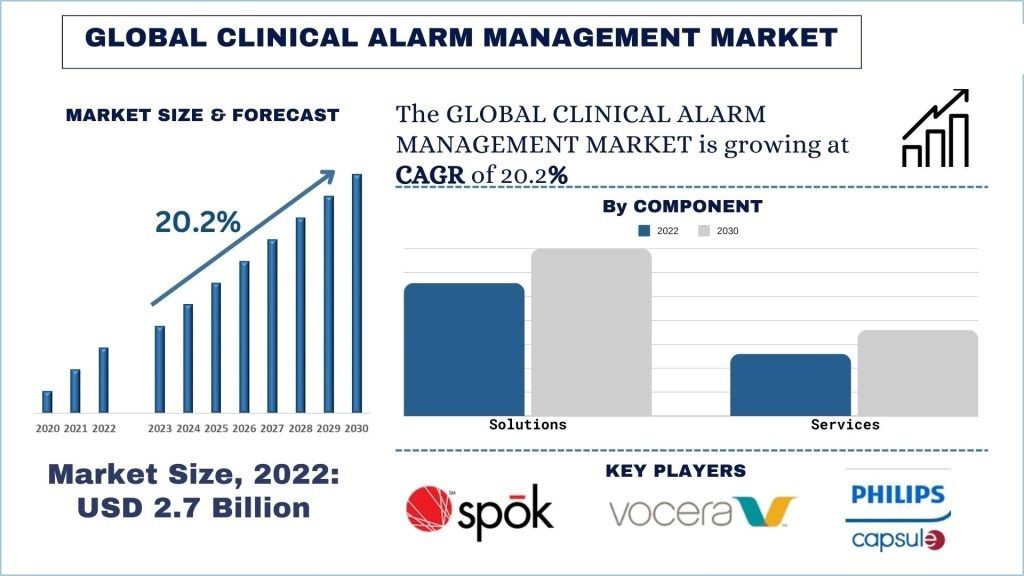
Dimensioni e previsioni del mercato della gestione degli allarmi clinici
Il mercato della gestione degli allarmi clinici è stato valutato a 2,7 miliardi di dollari USA e si prevede che crescerà a un forte CAGR di circa il 20,2% durante il periodo di previsione (2023-2030) a causa della crescente prevalenza di malattie croniche.
Analisi del mercato della gestione degli allarmi clinici
Il mercato della gestione degli allarmi clinici sta crescendo a causa di diversi motivi, tra cui l'aumento della spesa sanitaria, la crescita delle collaborazioni strategiche e i crescenti progressi tecnologici. La crescente incidenza globale di malattie croniche ha contribuito a un aumento dei ricoveri ospedalieri e a degenze più lunghe, guidando così la domanda di allarmi clinici.
Secondo Statistics Canada, le malattie croniche come il cancro e le malattie cardiache sono rimaste le due principali cause di morte in Canada, rappresentando il 41,8% dei decessi nel 2022. Nel 2021, queste malattie rappresentavano il 44,3% di tutti i decessi.
Inoltre, nel febbraio 2024, Royal Philips ha ricevuto l'autorizzazione 510(k) per il suo software più recente per il monitoraggio dei pazienti IntelliVue, che include la disponibilità tanto attesa di diverse nuove soluzioni, tra cui il premiato pacchetto di allarmi Philips Sounds, che ammorbidisce e arrotonda i toni degli allarmi e regola gli intervalli degli allarmi per segnalare più delicatamente lo stato o richiedere l'azione utilizzando una serie di suoni di allarme più rilassanti e di grande impatto. Tali progressi tecnologici stanno guidando la crescita del mercato durante il periodo di previsione.
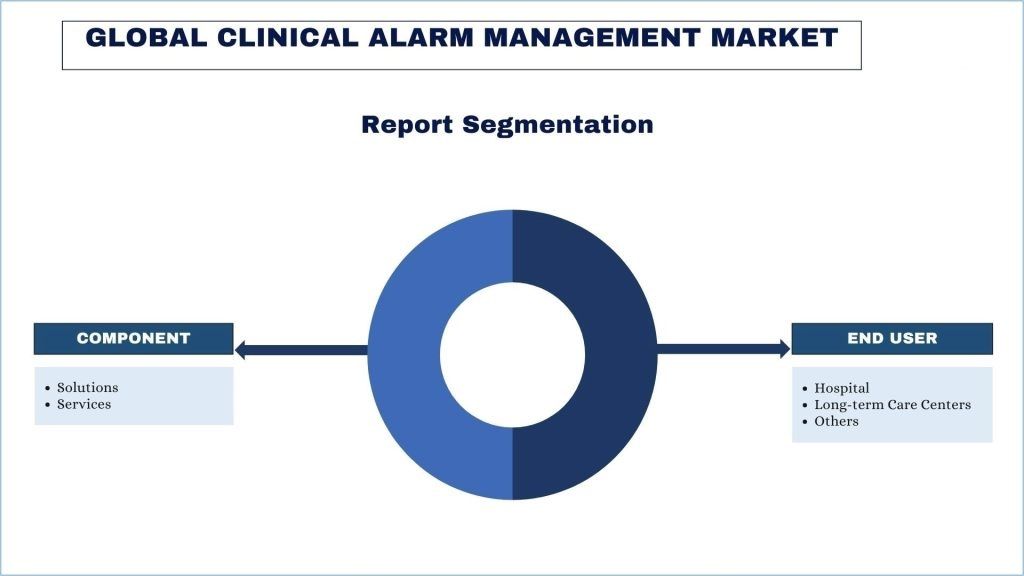
Trend del mercato della gestione degli allarmi clinici
Questa sezione analizza i principali trend di mercato che influenzano i vari segmenti del mercato della gestione degli allarmi clinici, come identificato dal nostro team di esperti di ricerca.
L'intelligenza artificiale trasforma l'industria dei dispositivi medici
La tendenza all'integrazione dell'intelligenza artificiale (IA) e dell'apprendimento automatico (ML) nei sistemi di gestione degli allarmi clinici. Le tecnologie di IA e ML sono sempre più incorporate nei sistemi di gestione degli allarmi clinici per migliorarne l'efficacia. Gli algoritmi di IA e ML possono analizzare i dati storici dei monitor dei pazienti e di altri dispositivi medici per prevedere quando è probabile che si verifichino allarmi. Gli algoritmi di IA possono imparare dai dati dei singoli pazienti per personalizzare le impostazioni degli allarmi in base alle loro esigenze e condizioni specifiche. Questa integrazione completa dei dati migliora la comprensione contestuale degli allarmi, consentendo ai medici di prendere decisioni più informate. Pertanto, l'integrazione delle tecnologie di IA e ML nei sistemi di gestione degli allarmi clinici è molto promettente per migliorare la sicurezza dei pazienti, ridurre l'affaticamento da allarmi e migliorare l'efficienza dell'erogazione dell'assistenza sanitaria. Ad esempio, nel febbraio 2024, il Vanderbilt University Medical Center ha eseguito un nuovo studio per dimostrare la promessa dell'intelligenza artificiale per aiutare a perfezionare e indirizzare la miriade di avvisi computerizzati destinati ad assistere i medici e altri membri del team nel processo decisionale clinico quotidiano.
Si prevede che il Nord America crescerà con un CAGR significativo durante il periodo di previsione
All'interno del Nord America, gli Stati Uniti detengono una quota importante del mercato. I principali fattori che promuovono la crescita del mercato nel paese sono il crescente numero di casi di malattie croniche, l'aumento dei ricoveri ospedalieri, il miglioramento delle infrastrutture ospedaliere, la crescente attenzione alla ricerca e sviluppo, un'infrastruttura sanitaria ben consolidata e la presenza di diversi operatori di mercato.
Secondo una fonte governativa, i Centers for Disease Control and Prevention (CDC), si stima che 6 adulti su 10 negli Stati Uniti abbiano una malattia cronica. Questa statistica sottolinea l'enorme portata della popolazione che necessita di gestione degli allarmi clinici ed evidenzia la potenziale domanda del mercato.
Secondo l'American Hospital Association, nell'ottobre 2022 c'erano circa 6.093 ospedali negli Stati Uniti, che comprendono ospedali comunitari gestiti da organizzazioni non profit, nonché da governi statali e locali.
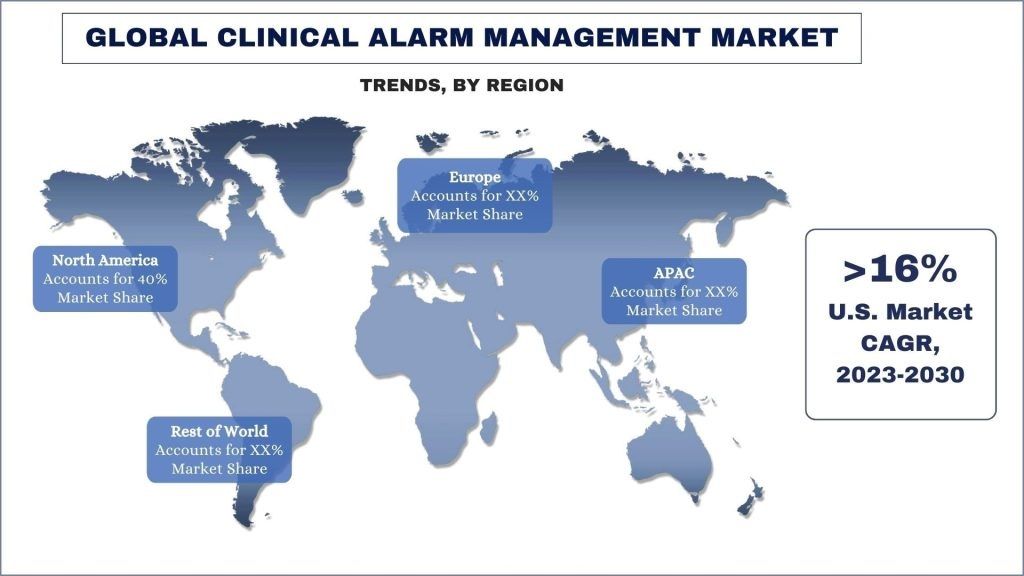
Panoramica del settore della gestione degli allarmi clinici
Il mercato della gestione degli allarmi clinici è competitivo, con la presenza di diversi operatori di mercato globali e internazionali. I principali operatori stanno adottando diverse strategie di crescita per migliorare la propria presenza sul mercato, come partnership, accordi, collaborazioni, nuovi lanci di prodotti, espansioni geografiche e fusioni e acquisizioni. Alcuni dei principali operatori che operano nel mercato sono GE HealthCare; Ascom; Spok, Inc.; Masimo; Hill-Rom Services, Inc.; Vocera Communications, Inc.; Capsule Technologies, Inc.; Medtronic; Connexall; e Mobile Heartbeat.
Notizie sul mercato della gestione degli allarmi clinici
- Nell'aprile 2023, Mobile Heartbeat, la principale azienda di comunicazione e collaborazione clinica, ha collaborato con Akkadian Labs per promuovere soluzioni di automazione per le imprese e i prodotti più venduti.
- Nel settembre 2021, Baxter ha acquisito Hill-Rom Services Inc. per espandere l'assistenza connessa e l'innovazione medica a livello globale.
- Nel gennaio 2021, Masimo ha lanciato iSirona, un hub di connettività compatto e versatile progettato per massimizzare l'interoperabilità in tutto il continuum di cura. L'hub iSirona offre un modo efficiente per connettere fisicamente fino a sei dispositivi medici al letto del paziente e instradare automaticamente i dati alla piattaforma Masimo Hospital Automation, una soluzione di connettività indipendente dal fornitore per l'integrazione EMR, il monitoraggio della sorveglianza, la gestione degli allarmi, le notifiche mobili, i display intelligenti e l'analisi.
Copertura del rapporto di mercato sulla gestione degli allarmi clinici
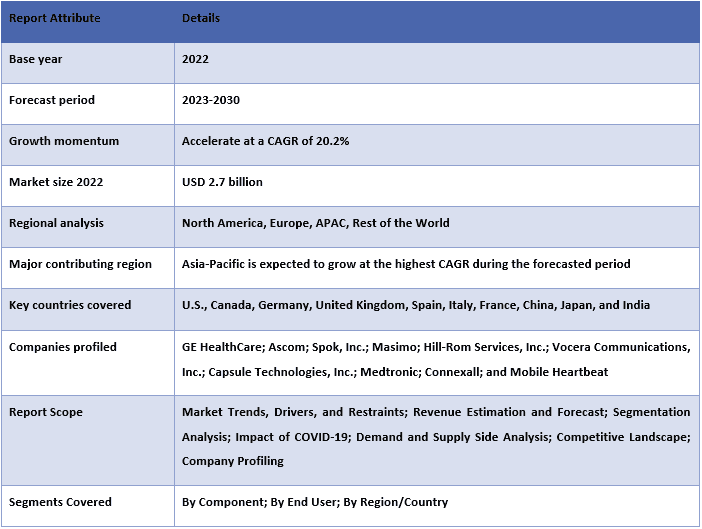
Copertura del rapporto di mercato sulla gestione degli allarmi clinici
Motivi per acquistare questo rapporto:
- Lo studio include l'analisi delle dimensioni del mercato e delle previsioni convalidate da esperti chiave del settore autenticati.
- Il rapporto presenta una rapida panoramica delle prestazioni complessive del settore a colpo d'occhio.
- Il rapporto copre un'analisi approfondita dei principali concorrenti del settore con un focus primario sui principali dati finanziari aziendali, sui portafogli di prodotti, sulle strategie di espansione e sugli sviluppi recenti.
- Esame dettagliato dei driver, dei vincoli, dei trend chiave e delle opportunità prevalenti nel settore.
- Lo studio copre in modo completo il mercato in diversi segmenti.
- Analisi approfondita a livello regionale del settore.
Opzioni di personalizzazione:
Il mercato globale della gestione degli allarmi clinici può essere ulteriormente personalizzato in base alle esigenze o a qualsiasi altro segmento di mercato. Inoltre, UMI comprende che potresti avere le tue esigenze aziendali, quindi sentiti libero di metterti in contatto con noi per ottenere un rapporto che si adatti completamente alle tue esigenze.

Puoi anche acquistare parti di questo rapporto. Vuoi dare un'occhiata a un listino prezzi
in base alla sezione?
Indice
Metodologia di ricerca per l'analisi del mercato della gestione degli allarmi clinici (2023-2030)
L'analisi del mercato storico, la stima del mercato attuale e la previsione del mercato futuro del mercato globale della gestione degli allarmi clinici sono stati i tre passaggi principali intrapresi per creare e analizzare l'adozione della gestione degli allarmi clinici nelle principali regioni a livello globale. È stata condotta un'esaustiva ricerca secondaria per raccogliere i dati storici del mercato e stimare le dimensioni attuali del mercato. In secondo luogo, per convalidare queste intuizioni, sono state prese in considerazione numerose scoperte e ipotesi. Inoltre, sono state condotte anche esaustive interviste primarie con esperti del settore lungo tutta la catena del valore del mercato globale della gestione degli allarmi clinici. Dopo l'ipotesi e la convalida dei dati di mercato attraverso interviste primarie, abbiamo impiegato un approccio top-down/bottom-up per prevedere le dimensioni complete del mercato. Successivamente, sono stati adottati metodi di suddivisione del mercato e triangolazione dei dati per stimare e analizzare le dimensioni del mercato dei segmenti e dei sottosegmenti del settore di riferimento. La metodologia dettagliata è spiegata di seguito:
Analisi delle dimensioni storiche del mercato
Passaggio 1: studio approfondito delle fonti secondarie:
È stato condotto uno studio secondario dettagliato per ottenere le dimensioni storiche del mercato della gestione degli allarmi clinici attraverso fonti interne aziendali come relazioni annuali e bilanci, presentazioni sulle performance, comunicati stampa, ecc. e fonti esterne tra cui riviste, notizie e articoli, pubblicazioni governative, pubblicazioni della concorrenza, rapporti di settore, database di terze parti e altre pubblicazioni credibili.
Passaggio 2: segmentazione del mercato:
Dopo aver ottenuto le dimensioni storiche del mercato della gestione degli allarmi clinici, abbiamo condotto un'analisi secondaria dettagliata per raccogliere informazioni storiche sul mercato e la quota per diversi segmenti e sottosegmenti per le principali regioni. I segmenti principali inclusi nel report sono componente, utente finale e regione. Sono state condotte ulteriori analisi a livello di paese per valutare l'adozione complessiva dei modelli di test in quella regione.
Passaggio 3: analisi dei fattori:
Dopo aver acquisito le dimensioni storiche del mercato di diversi segmenti e sottosegmenti, abbiamo condotto una analisi dei fattori dettagliata per stimare le dimensioni attuali del mercato della gestione degli allarmi clinici. Inoltre, abbiamo condotto l'analisi dei fattori utilizzando variabili dipendenti e indipendenti come componente, utente finale e regione del mercato della gestione degli allarmi clinici. È stata condotta un'analisi approfondita degli scenari di domanda e offerta considerando le principali partnership, fusioni e acquisizioni, espansione aziendale e lanci di prodotti nel settore del mercato della gestione degli allarmi clinici in tutto il mondo.
Stima e previsione delle dimensioni attuali del mercato
Dimensionamento attuale del mercato: sulla base di informazioni fruibili derivanti dai 3 passaggi precedenti, siamo giunti alle dimensioni attuali del mercato, ai principali attori nel mercato globale della gestione degli allarmi clinici e alle quote di mercato dei segmenti. Tutte le quote percentuali richieste e le suddivisioni del mercato sono state determinate utilizzando l'approccio secondario sopra menzionato e sono state verificate tramite interviste primarie.
Stima e previsione: per la stima e la previsione del mercato, sono stati assegnati pesi diversi a fattori diversi, tra cui driver e tendenze, vincoli e opportunità disponibili per le parti interessate. Dopo aver analizzato questi fattori, sono state applicate le tecniche di previsione pertinenti, ovvero l'approccio top-down/bottom-up, per arrivare alla previsione di mercato per il 2030 per diversi segmenti e sottosegmenti nei principali mercati a livello globale. La metodologia di ricerca adottata per stimare le dimensioni del mercato comprende:
- Le dimensioni del mercato del settore, in termini di entrate (USD) e il tasso di adozione del mercato della gestione degli allarmi clinici nei principali mercati a livello nazionale
- Tutte le quote percentuali, le suddivisioni e le ripartizioni dei segmenti di mercato e dei sottosegmenti
- I principali attori nel mercato globale della gestione degli allarmi clinici in termini di prodotti offerti. Inoltre, le strategie di crescita adottate da questi attori per competere nel mercato in rapida crescita
Convalida delle dimensioni e della quota di mercato
Ricerca primaria: sono state condotte interviste approfondite con i Key Opinion Leaders (KOL) tra cui dirigenti di alto livello (CXO/VP, responsabile vendite, responsabile marketing, responsabile operativo, responsabile regionale, responsabile paese, ecc.) nelle principali regioni. I risultati della ricerca primaria sono stati quindi riepilogati ed è stata eseguita un'analisi statistica per dimostrare l'ipotesi dichiarata. Gli input della ricerca primaria sono stati consolidati con i risultati secondari, trasformando quindi le informazioni in intuizioni fruibili.
Ripartizione dei partecipanti primari in diverse regioni
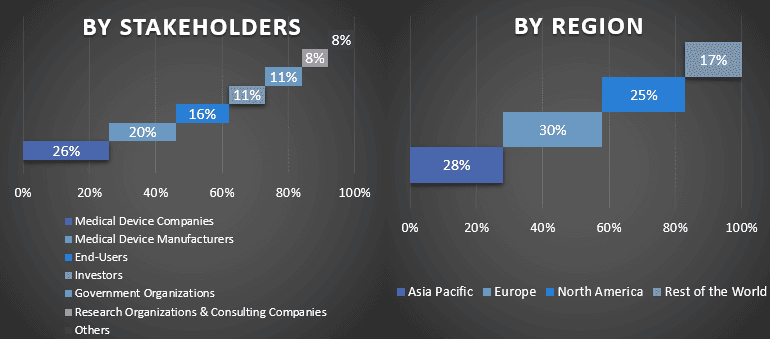
Ingegneria del mercato
La tecnica di triangolazione dei dati è stata impiegata per completare la stima complessiva del mercato e per arrivare a dati statistici precisi per ciascun segmento e sottosegmento del mercato globale della gestione degli allarmi clinici. i dati sono stati suddivisi in diversi segmenti e sottosegmenti dopo aver studiato vari parametri e tendenze nelle aree del componente, dell'utente finale e della regione nel mercato globale della gestione degli allarmi clinici.
L'obiettivo principale dello studio sul mercato globale della gestione degli allarmi clinici
Le tendenze attuali e future del mercato globale della gestione degli allarmi clinici sono state individuate nello studio. Gli investitori possono ottenere informazioni strategiche per basare la propria discrezione per gli investimenti sull'analisi qualitativa e quantitativa eseguita nello studio. Le tendenze attuali e future del mercato hanno determinato l'attrattiva complessiva del mercato a livello regionale, fornendo una piattaforma per il partecipante industriale per sfruttare il mercato non sfruttato per beneficiare di un vantaggio di first-mover. Altri obiettivi quantitativi degli studi includono:
- Analizzare le dimensioni attuali e previste del mercato della gestione degli allarmi clinici in termini di valore (USD). Inoltre, analizzare le dimensioni attuali e previste del mercato di diversi segmenti e sottosegmenti
- I segmenti nello studio includono aree del componente, dell'utente finale e della regione
- Definire e analizzare il quadro normativo per l'industria della gestione degli allarmi clinici
- Analizzare la catena del valore coinvolta con la presenza di vari intermediari, insieme all'analisi dei comportamenti dei clienti e dei concorrenti del settore
- Analizzare le dimensioni attuali e previste del mercato della gestione degli allarmi clinici per la principale regione
- I principali paesi delle regioni studiate nel report includono Asia Pacifico, Europa, Nord America e il resto del mondo
- Profili aziendali del mercato della gestione degli allarmi clinici e le strategie di crescita adottate dagli operatori di mercato per sostenersi nel mercato in rapida crescita
- Analisi approfondita a livello regionale del settore
Domande frequenti FAQ
Q1: Qual è la dimensione attuale del mercato e il potenziale di crescita del mercato della gestione degli allarmi clinici?
Q2: Quali sono i fattori trainanti per la crescita del mercato della gestione degli allarmi clinici?
Q3: Quale segmento detiene la quota maggiore del mercato della gestione degli allarmi clinici per componente?
Q4: Quali sono le tecnologie e le tendenze emergenti nel mercato della gestione degli allarmi clinici?
Q5: Quale regione dominerà il mercato della gestione degli allarmi clinici?
Correlati Report
I clienti che hanno acquistato questo articolo hanno acquistato anche










